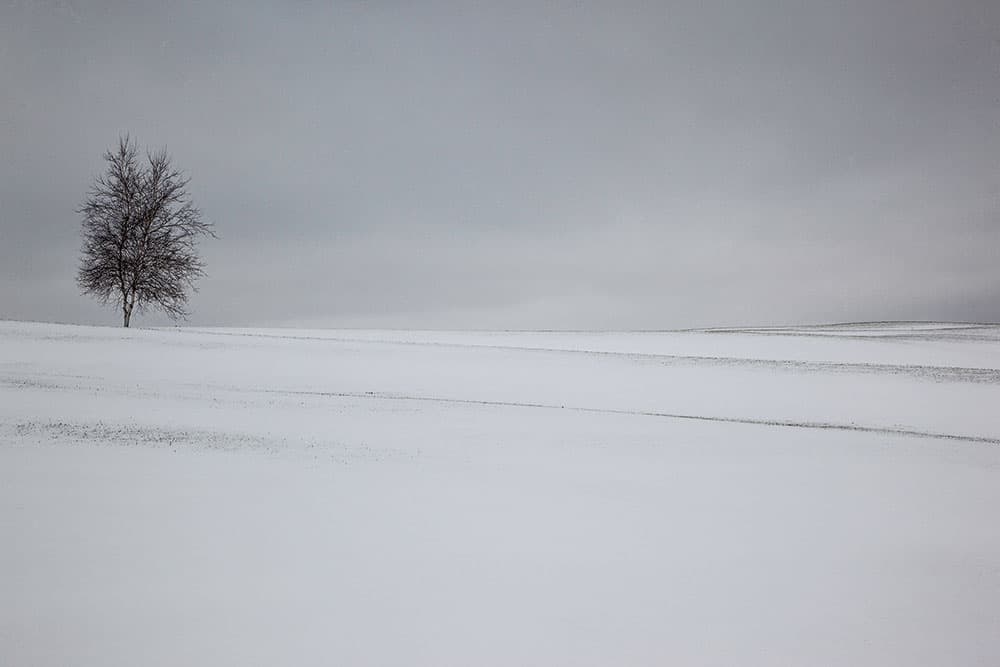
Bad weather photography can offer up some great opportunities. Snow has the capacity to simplify the landscape, offering a wonderfully minimalist transformation. Credit: Tony Worobiec
Weather is the defining quality of any landscape, and the wilder it is the more interesting your photographs will appear. It governs the two most important features of landscape – notably, lighting and mood. As we slip into winter, the weather certainly can prove more challenging, and the temptation can be for some to pack their cameras away.
The purpose of this feature is to urge you not to give in and to embrace what the forthcoming months have to offer. Whether the skies are grey, it’s throwing it down with rain, or you are enveloped in fog, instead of viewing this as a problem, count your good fortune and embrace these exciting possibilities.
Bad weather photography: Grey skies
When the skies appear featureless and overcast, it is tempting not to venture out, but the important point to remember is that you cannot change the weather, but you can change your location. Once you understand this simple principle, no day will ever be wasted. While the idea of a grey sky conjures up a certain negativity, it is important to appreciate that it also evokes a specific mood that can work well in certain landscape situations. For example, abandoned places or areas that exude pathos work far more effectively when photographed under a grey sky.
The skill is to match the location with the available weather. Grey skies can be anything from flat, featureless cloud, to something more dramatic. Viewed positively, each offers fabulous opportunities for exciting landscape photography. From a technical standpoint, shooting under grey skies is relatively easy – with a reduction of contrast, it will prove considerably easier to keep the histogram within the 0-255 tonal range.
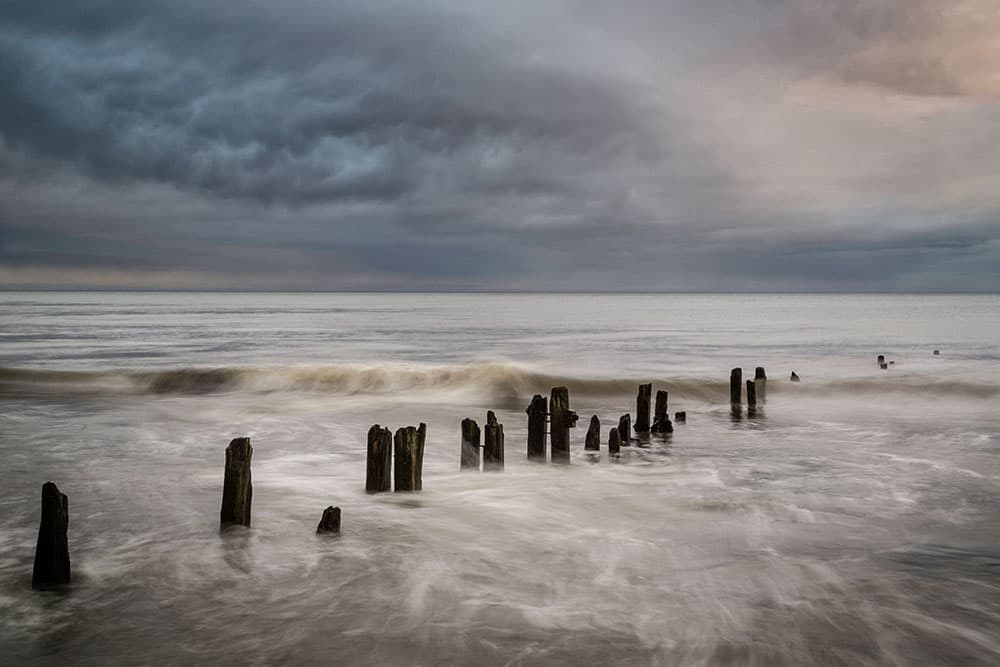
Groynes at Sandsend in North Yorkshire. When experiencing grey skies, look for a subject that chimes with the mood. Credit: Tony Worobiec
Bad weather photography: Rain
While I am sure many of you will share my enthusiasm for grey skies, I suspect fewer will be as keen to photograph in rain. If you are discouraged, don’t be, because some truly awesome images can be taken when it’s wet; it just takes a bit more commitment. In common with grey skies, rain offers many varieties, each presenting unique challenges. We can experience a gentle rain through to a full-blown deluge. Obviously, when considering the latter, it’s better if both you and your camera remain dry.
It is difficult to muster the enthusiasm to take pictures once you are drenched and, on a similar tack, most DSLR cameras are vulnerable to heavy rain and can sustain serious damage if they are not adequately protected. The top-plate and the back of your camera are especially vulnerable. If you are driving and it is pouring with rain, it is very easy to dismiss a potentially exciting shot. If, however, you are already wearing your waterproofs, you will be more inclined to stop.
10 bad weather photography tips for shooting in rain
- Choose your location carefully Urban areas make great subjects in the rain. Surfaces such as wet tarmac reflect beautifully, especially at night.
- Judge the direction of the rain If it’s blowing towards you, your lens’s front element will soon be covered in droplets.
- Use a UV filter It’s far better to get moisture on the filter, rather than on your expensive lens.
- Clean your lens Keep checking the front of your lens, and have a clean microfibre cloth available to clean off any droplets.
- Try handheld Don’t assume you should always use a tripod. Consider shooting handheld, too.
- Increase the ISO if necessary The sensors on modern DSLRs are quite capable of delivering excellent results, even with the ISO set to 4000.
- Use a long lens I am a fan of using long lenses when capturing weather – you can then shoot from a sheltered spot.
- Always have a lens hood attached Another advantage of using a long lens, as their hoods tend to be very deep.
- Experiment with shutter speeds A slow shutter speed is great, but try using a faster one, particularly when there are figures in frame.
- Keep your camera dry Personally, I find purpose-made camera rain sleeves too elaborate, and prefer using a simple plastic bag or even a cheap shower cap.
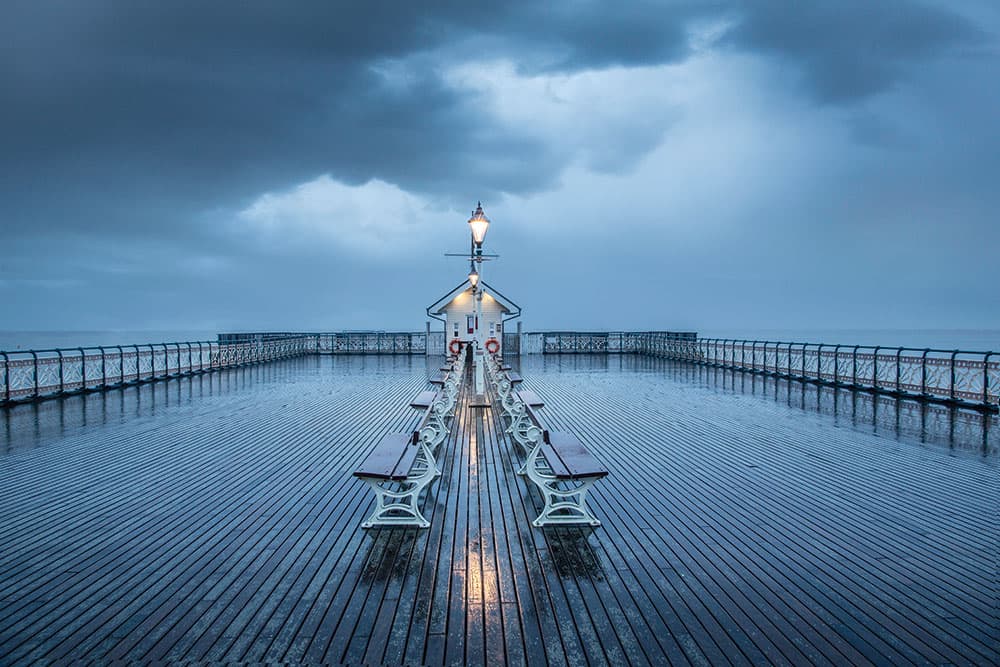
Penarth Pier in South Wales during a heavy shower. Urban locations, and piers in particular, can appear utterly transformed when photographed in rain. Credit: Tony Worobiec
Continues below…
[collection name=”small”]
Bad weather photography: Ice and snow
I am struggling to think of any serious landscape photographer who would not be excited by the prospect of ice and snow; a snowy scene retains a charm few can resist. Predicting snow is not too difficult and, to its credit, the Met Office’s predictions often prove surprisingly accurate. If you are fortunate enough to be out shooting in the snow, look for simple designs. Landscape often assumes a marvellous graphical quality, particularly if the snow is moderately light. Farm tracks, ploughed fields, remnants of harvested fields – all leave distinctive marks that offer amazing photographic potential.
If, by way of contrast, you experience a much heavier snowfall, look for the opportunities for a minimalist landscape. The landscape will appear overwhelmingly white, with just the odd dark area punctuating the light. The high-key nature of the images also helps to contribute to this minimalist approach. If you have metered your landscape correctly and checked the histogram, you will see that the tonal values are bunching to the right. With a very limited tonal range and very few visual elements, you should be able to produce images of stunning simplicity.
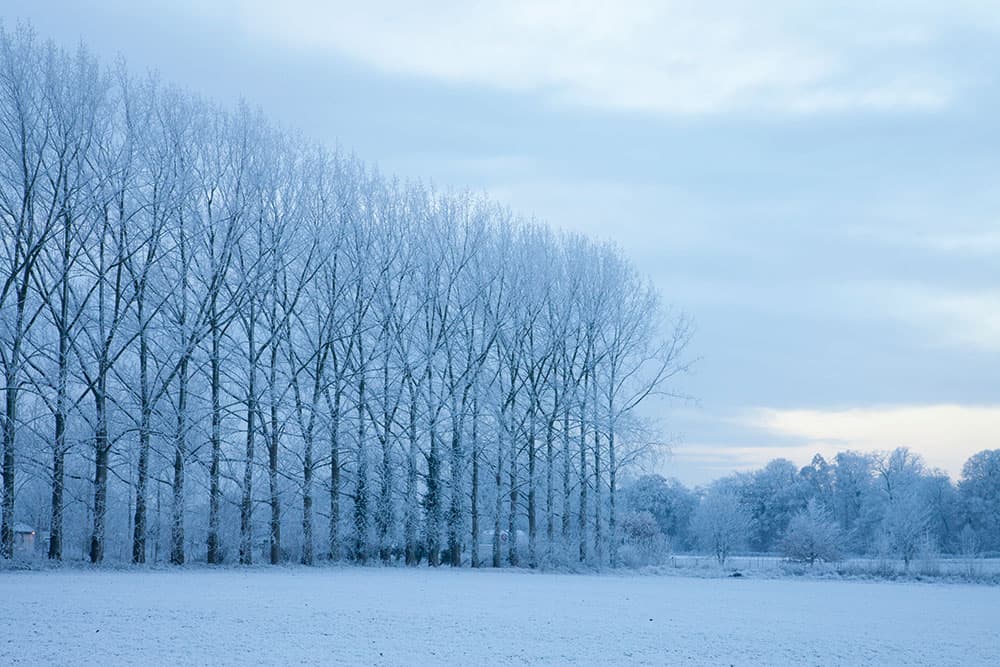
Trees in snow. When photographing in snow, take some time to look for striking, graphical effects. Credit: Tony Worobiec
Bad weather photography: Mist and fog
OK, time to be realistic – there can’t be many photographers who would think to place mist and fog under the umbrella of ‘bad weather’. Even the most inexperienced landscape photographers get excited by it. As fog tends to reduce colour saturation considerably, a much stronger emphasis is placed on the image’s tonal values. Consequently, images taken in fog can often be very successfully converted to black & white.
If, however, you choose to retain the colour, the hues will appear wonderfully subtle. When photographing in fog, you can explore a visual phenomenon known as tonal recession. What this means is that distant objects appear considerably lighter than those closer to the camera; this is especially apparent when photographing a cluster of trees. The tonal interplay between the trees in the distance and those nearer the camera can prove particularly transformational. Because of the reduced visibility, images tend to be simpler and more graphic in nature.
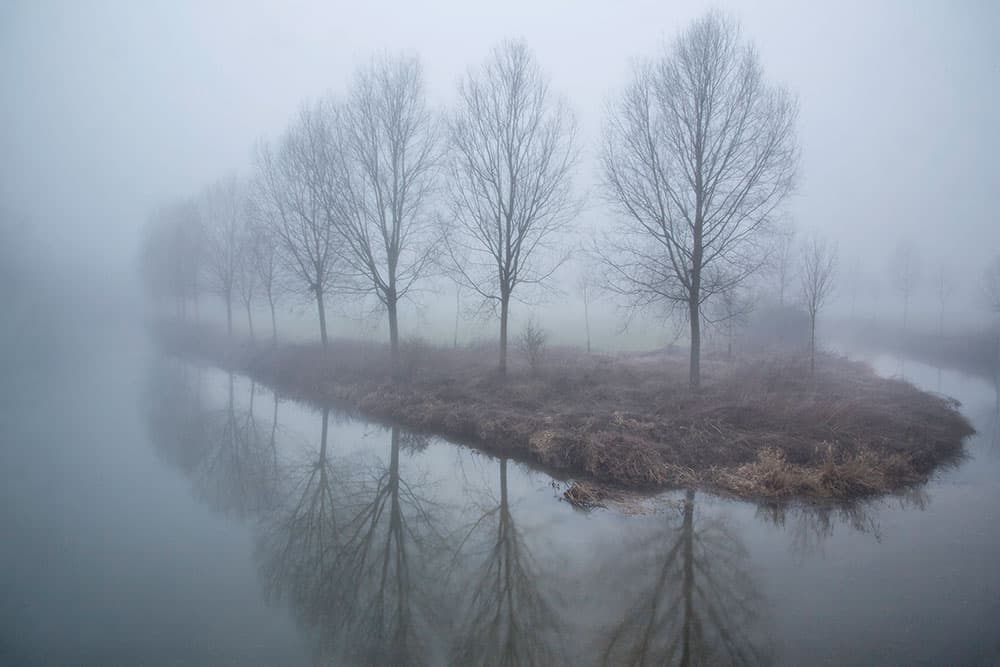
The River Stour, Dorset. In normal conditions it is possible to see a cluster of houses to the extreme left, but here the mist has masked them. Credit: Tony Worobiec
Bad weather photography: Wind
Wind is a contradictory phenomenon insofar as it is invisible, and yet you can see the evidence all around you. Shooting in the wind certainly has its drawbacks. For example, if you are using a tripod and aren’t sufficiently sheltered, the buffeting can cause camera shake, especially when using a long telephoto lens. On a more positive note, wind also introduces drama to the landscape and is capable of transforming the ordinary into the extraordinary. From a technical standpoint, remember you do have a variety of shutter speeds to play with.
Landscape photographers often prefer to use the AV rather than the TV option as they consider controlling depth of field to be more important than shutter speed. When photographing in the wind, however, it’s a good idea to make the shutter speed your priority. It could be that you want to capture some object being blown in the wind that requires a fast shutter speed. Alternatively, capturing the moving clouds might be another way of illustrating wind, which then requires using an extended shutter speed.
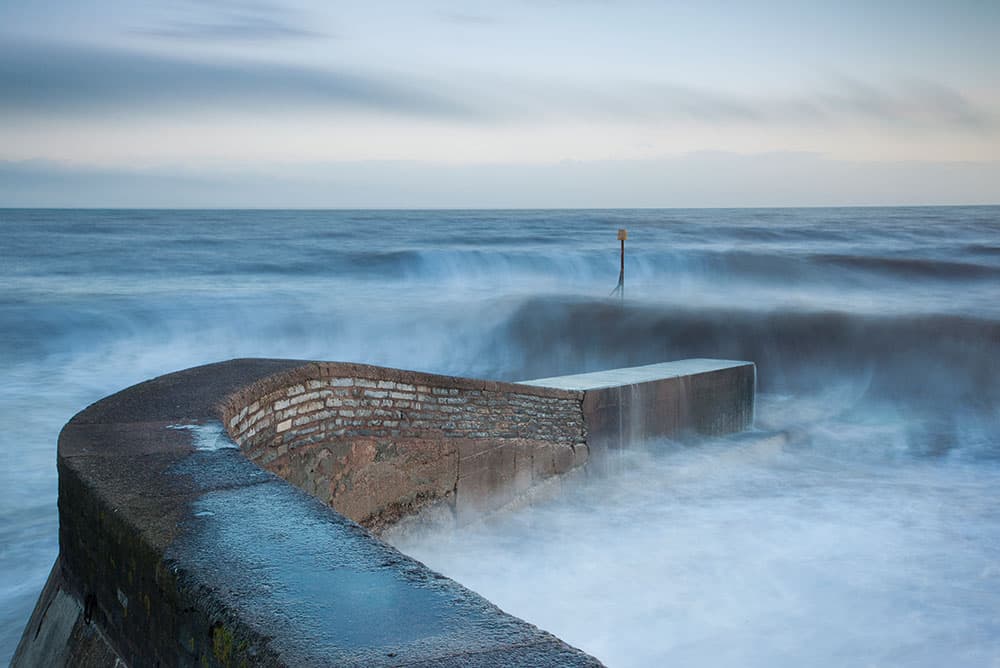
Waves off a jetty at Sidmouth. When you notice the wind is up, why not head to the coast. Credit: Tony Worobiec
Bad weather photography kit list
Long telephoto lens
My 100-400mm zoom is a revelation as it allows me to enter into the ‘spirit’ of the landscape. From an aesthetic standpoint, I enjoy the compression effect these lenses give.
Tripod
A solid tripod is crucial. There will be many times when you need to use a very small aperture, which, of course, requires a slow shutter speed.
Think Tank camera bag
Aside from the excellent construction, I also value its rain cover. It keeps the bag dry and can also be used as a groundsheet should you want to place your bag on a wet surface.
Neutral Density filter
These come in a variety of strengths, and are useful when you want to reduce the shutter speed, particularly when shooting rain or wind.
Clean microfibre cloth
Moisture and bad weather go hand in hand, so whether you are photographing a coastal location in high winds, or a dewy forest in heavy mist, you will find droplets of water on the front element, which will need cleaning.
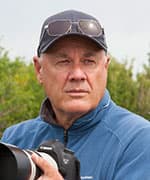
Tony Worobiec FRPS has had 16 books published, the most recent of which is Photographing Landscape Whatever The Weather (RHE Media Ltd, ISBN 978-19102- 2642-1). He has won awards for photography in the UK and internationally, and has had his work exhibited in numerous prestigious venues.








